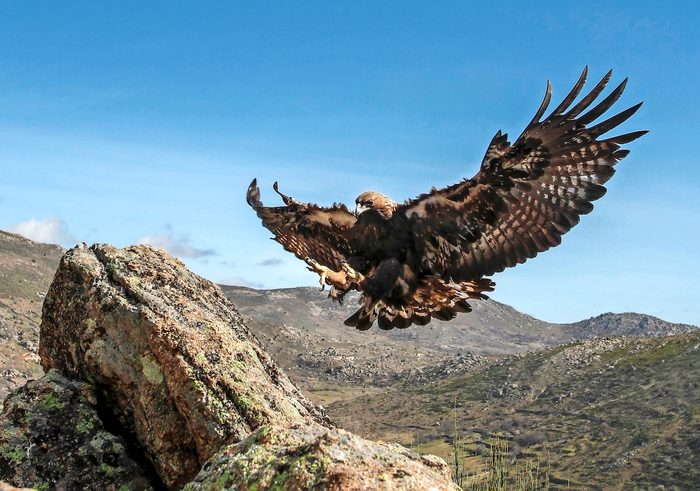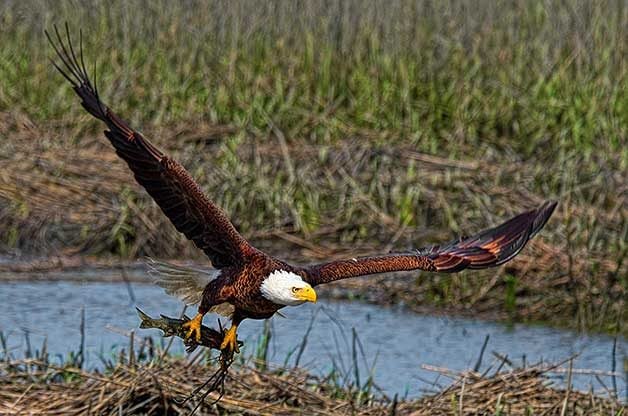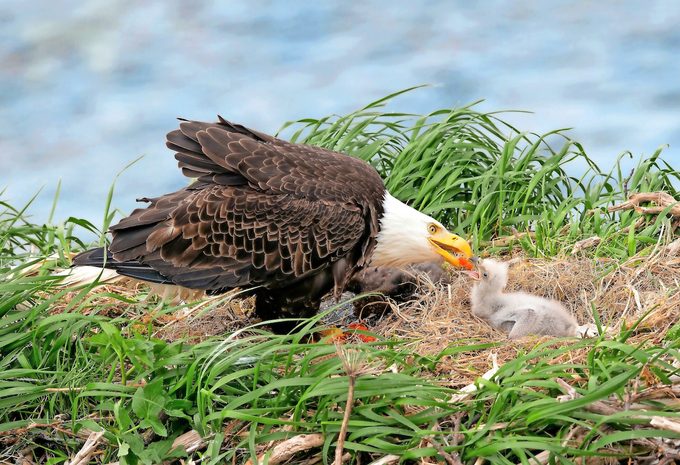Bald Eagles and Golden Eagles: The Types of Eagles in North America
Updated: Feb. 09, 2023

Experts explain similarities and differences between bald eagles and golden eagles, including what these types of eagles eat and how they raise their young.
It’s awe-inspiring to look up and see a bald eagle or a golden eagle soaring overhead. With similar names and resemblance in their younger life stages, it’s natural to assume they are closely related. But aside from the fact that they both belong to the hawk family, these two types of eagles are very distant relatives, and they have extremely different lifestyles. Discover 7 interesting bald eagle facts.
Two Different Types of Eagles
The name eagle is applied to more than 60 members of the hawk family around the world (see our tips on how to identify Cooper’s hawks and sharp-shinned hawks). They’re a diverse selection, mostly large to medium in size, but not necessarily related. The two types of eagles in North American represent distinct groups.
The bald eagle is a typical member of a group of about eight species known as sea eagles or fish eagles. They’re most often seen along coastlines or around lakes and rivers and are widespread in North America, Europe, Asia, Africa, Australia and many islands.
The golden eagle belongs to a group that includes about a dozen species, and they’re also found on the same five continents. They generally live in dry interior country, however, not along coastlines, and they’re less likely to be found on islands.
These two groups of eagles are equally widespread, but the bald eagle itself is a specialty of North America, found only from Alaska and Canada south to northern Mexico. The golden eagle is widespread in North America, especially in the West, and it also lives across the wilder regions of Europe, Asia and parts of northern Africa.
Psst—golden eagles are one of the fastest birds in North America.

What Do Eagles Eat?
Both types of eagles are powerful predators and have varied diets. The tops of their menus are different, though. Bald eagles prefer fish, while golden eagles feed mainly on small mammals.
Bald eagles often hunt by flying over the water and then swooping down to grab a fish near the surface with their strong talons. They also steal fish that have been caught by other birds, like ospreys or other bald eagles, and they’re just as likely to eat dead fish that have washed up on shore.
Check out 20 stunning and inspiring photos of bald eagles.
Golden eagles almost never eat fish, by contrast. Their mainstays are mammals like jack rabbits, prairie dogs and ground squirrels. They also catch large birds such as grouse and ducks. Both species are scavengers (but you might not guess it from their majestic looks). They take advantage of easy sources of food like roadkill and other carrion.
Learn how birds use their feathers, beaks and feet.
Eagle Nesting Habits and Raising Young
Both bald and golden eagles build large nests out of sticks. Pairs may use the same nest for years, continuing to bring new material to add to it each year, creating a massive structure.
The two types of eagles prefer different kinds of nest sites, however. Bald eagles usually place their nests in large trees. Although they’ll sometimes build the nest on a cliff or even on the ground on an island. Golden eagles usually choose a site on a cliff, but will build in large trees on flat land, too.
The females in both species lay one to three eggs, with two being the typical number. Each parent takes part in incubating the eggs, but the female does more of it. The male often brings her food at the nest. The female stays with the young after they hatch while the male hunts to bring back food for the family. Both parents will go off to find food for the growing eaglets as they get older.
Raising a family is a lengthy process for these big birds. Golden eagles incubate eggs for about six weeks until they hatch; then it’s about another 10 weeks until the young learn to fly. Bald eagles’ incubation period is about five weeks, but it may be another 11 to 13 weeks before the young eagles take to the air.
Learn how to identify bird eggs by color and size.
Eagle Conservation Efforts and Recovery
Bald eagles were seriously endangered 50 years ago. Their populations had been decimated by illegal shooting and especially by the effects of DDT and other pesticides. Fewer than 500 pairs were left in the Lower 48, and most of those pairs were failing to raise young.
The eagles have made a spectacular recovery since the 1970s with increased protection. There are now well over 10,000 pairs in the Lower 48, plus many more in Canada and Alaska. One heartwarming rescue story is about Beauty, a bald eagle that needed a new beak after she was shot.
No matter how many times you see an eagle, it always takes your breath away. The more you understand about their lifestyles and behaviors, the better you can protect their populations. These efforts will ensure that future generations will also gasp in awe at the sight of these magnificent birds.





















